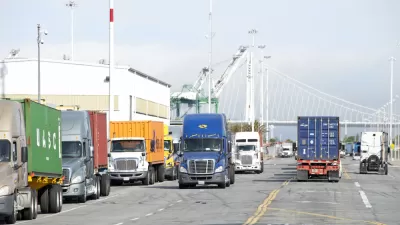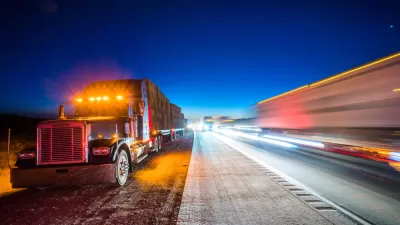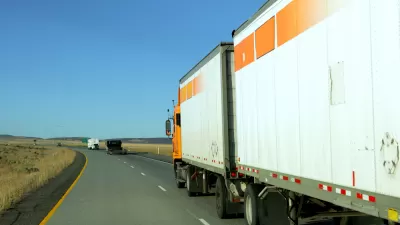A new report from the Congressional Budget Office places the spotlight on the trucking industry in terms of the social, health ,and environmental costs it imposes on society but does not pay for, i.e., externalities.
"A new report from the Congressional Budget Office (CBO) estimates that truck freight causes more than $58 to $129 billion annually in damages and social costs in the form of wear and tear on the roads, crashes, congestion and pollution – an amount well above and beyond what trucking companies currently pay in taxes," writes Joe Cortright of City Observatory, "a virtual think tank on urban issues funded by the John S. and James L. Knight Foundation."
Because they don’t pay the costs of these negative externalities, the firms that send goods by truck don’t have to consider them when deciding how and where to ship goods. This translates into a huge subsidy for the trucking industry of between 21 and 46 cents per mile.
Rail Comparison
The "unpriced external cost are around eight times higher than rail," writes David Austin, an analyst in CBO's Microeconomics Studies Division, and author of the CBO report.
"Railroads have much lower social costs, for two reasons: first, rail transport is much more energy efficient and less polluting per ton mile of travel; second, because railroads are built and maintained by their private owners, most of the cost of wear and tear is borne by private users, not the public," writes Cortright.
Four options to internalize the costs - from project summary
- "Add taxes based on the weight or distance of each shipment." For example, as noted in a recent post on road damage caused by heavy vs. light trucks, the Oregon Department of Transportation's "Motor Carrier Transportation Division already charges 'all commercial trucks and buses weighing more than 26,000 pounds' a weight-mile tax [PDF]."
- "Increase the existing tax on diesel fuel." The federal tax, 24.4 cents per gallon, like the 18.4 cents gasoline tax, was last increased in 1993.
Additional reasons to increase diesel tax:
According to the Energy Information Administration, "about 19.64 pounds of carbon dioxide (CO2) are produced from burning a gallon of gasoline that does not contain ethanol. About 22.38 pounds of CO2 are produced by burning a gallon of diesel fuel."
According to the National Association of Convenience Stores, "U.S. gasoline demand has decreased since peaking in 2007, demand for diesel fuel has remained strong. U.S. clean diesel vehicle sales increased 25.6% in 2012, almost double the overall auto market's increase."
- "Implement a tax on the transport of shipping containers."
- "Increase the existing tax on truck tires."
It should be noted, though, that the American Trucking Associations has been a strong supported of increasing the fuel tax, as noted by Ashley Halsey III in the The Washington Post last February.
FULL STORY: The real welfare Cadillacs have 18 wheels

Study: Maui’s Plan to Convert Vacation Rentals to Long-Term Housing Could Cause Nearly $1 Billion Economic Loss
The plan would reduce visitor accommodation by 25,% resulting in 1,900 jobs lost.

Alabama: Trump Terminates Settlements for Black Communities Harmed By Raw Sewage
Trump deemed the landmark civil rights agreement “illegal DEI and environmental justice policy.”

Why Should We Subsidize Public Transportation?
Many public transit agencies face financial stress due to rising costs, declining fare revenue, and declining subsidies. Transit advocates must provide a strong business case for increasing public transit funding.

Paris Bike Boom Leads to Steep Drop in Air Pollution
The French city’s air quality has improved dramatically in the past 20 years, coinciding with a growth in cycling.

Why Housing Costs More to Build in California Than in Texas
Hard costs like labor and materials combined with ‘soft’ costs such as permitting make building in the San Francisco Bay Area almost three times as costly as in Texas cities.

San Diego County Sees a Rise in Urban Coyotes
San Diego County experiences a rise in urban coyotes, as sightings become prevalent throughout its urban neighbourhoods and surrounding areas.
Urban Design for Planners 1: Software Tools
This six-course series explores essential urban design concepts using open source software and equips planners with the tools they need to participate fully in the urban design process.
Planning for Universal Design
Learn the tools for implementing Universal Design in planning regulations.
Smith Gee Studio
Alamo Area Metropolitan Planning Organization
City of Santa Clarita
Institute for Housing and Urban Development Studies (IHS)
City of Grandview
Harvard GSD Executive Education
Toledo-Lucas County Plan Commissions
Salt Lake City
NYU Wagner Graduate School of Public Service





























